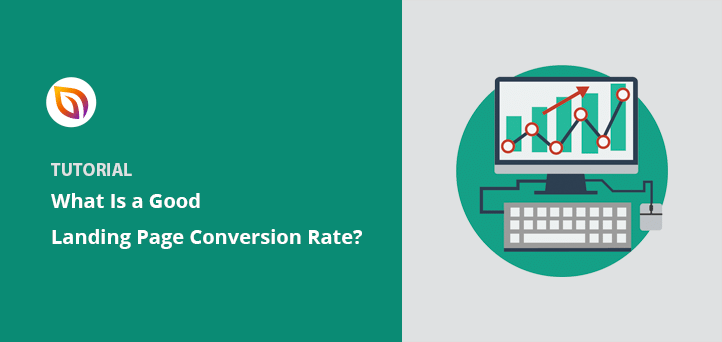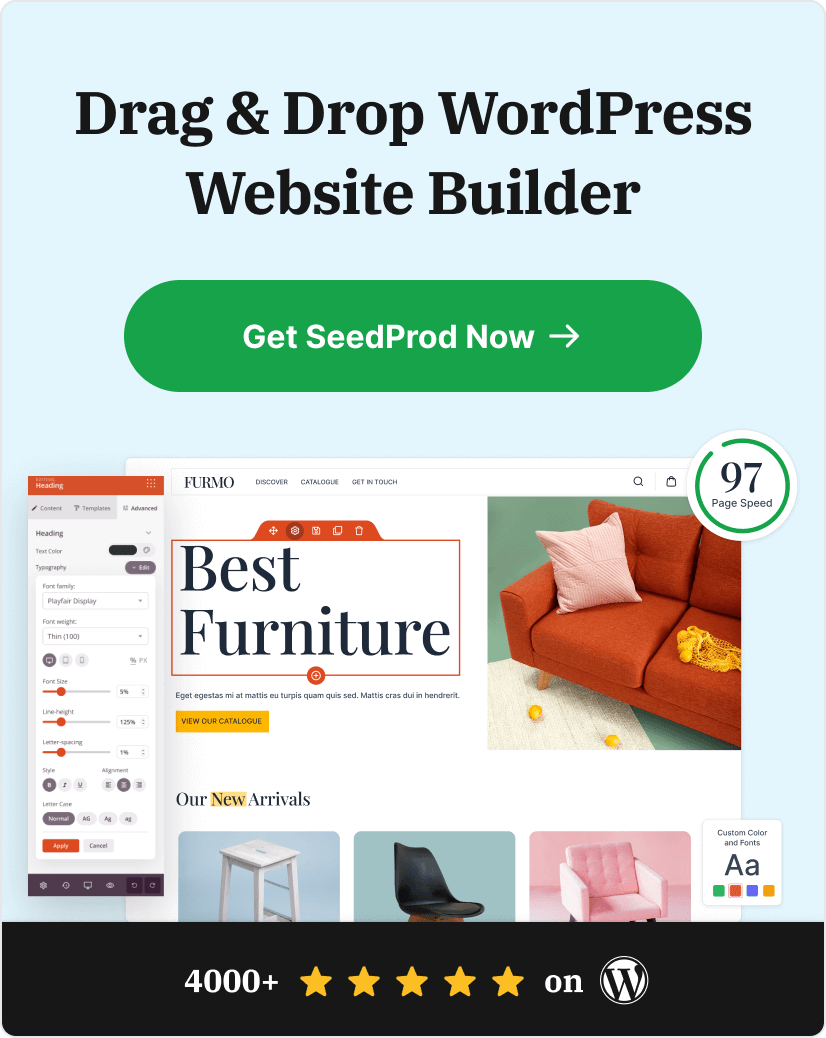Las páginas de destino son fundamentales para convertir a los visitantes en clientes. Incluso un pequeño aumento de la tasa de conversión de una página puede generar grandes ganancias. Por ejemplo, si una página recibe 100.000 visitas mensuales y la tasa de conversión aumenta del 2% al 2,5%, se crean 500 clientes más al mes.
Aumentar las tasas de conversión requiere trabajo, pero genera grandes beneficios. En esta guía, aprenderás más sobre qué son las tasas de conversión de las páginas de destino y cómo aumentarlas para hacer crecer tu negocio.
Índice
- What Is a Landing Page Conversion Rate?
- How to Calculate Landing Page Conversion Rates
- What's The Average Landing Page Conversion Rate?
- What's a Good Landing Page Conversion Rate?
- Why Are Conversion Rates Different for Every Industry?
- Tips to Increase Landing Page Conversion Rates
- Optimización de la tasa de conversión para páginas de destino Preguntas frecuentes
What Is a Landing Page Conversion Rate?
A landing page conversion rate tells you how good a landing page is at getting visitors to do what you want them to do. It’s like a score – the higher the score, the better the landing page.
Así es como funciona:
- You have a landing page on a website.
- You want people who visit that page to DO something specific, like sign up for your email list or buy a product.
- The conversion rate tells you what percentage of visitors actually do that thing.
So, if 100 people visit your landing page and 10 of them sign up for your email list, your conversion rate is 10%.
How to Calculate Landing Page Conversion Rates
You can use this landing page conversion rate formula to calculate the rates for your page:
- Divide the number of people who took the desired action by the total number of people who visited the page
- Multiply the result by 100 to get a percentage
For example, if 50 people signed up for a newsletter out of 1,000 visitors to your landing page, the conversion rate would be 5%: 50÷1,000×100=5%
But how do you know if that’s actually a good landing page conversion rate? We’ll tackle that next.
What’s The Average Landing Page Conversion Rate?
The average conversion rate for landing pages varies depending on your industry, target audience, and conversion goal.
According to HubSpot, the average conversion rate across all industries is 5.89%. However, the data varies wildly when you break it down.

Data source: Unbounce – landing page conversion rates by industry
Here are some average conversion rate by industry:
- Ecommerce Conversion Rate: 2.5-3.5%
- SaaS: 3-5%.
- Servicios financieros: 2-3%
- Sanidad: 2-5%.
- Educación: 3-5%
The key here is to remember that the average conversion rate for your landing page depends on your industry, audience, and goal.
What’s a Good Landing Page Conversion Rate?
As we mentioned above, there isn’t a single “good” landing page conversion rate overall. However, conversion rate benchmarks of around 10% are considered good across all industries.
But just aiming for a good conversion rate isn’t enough. You want a great conversion rate, which means outperforming your competitors.
Si su tasa de conversión no es la deseada, no se preocupe. Hay muchas formas de optimizar tu página de destino para obtener mejores resultados.
Conversion Rate Benchmarks by Landing Page Type
While 10% is considered a good overall conversion rate, it’s helpful to have more specific benchmarks based on the type of landing page you’re using. Here are some average conversion rates for different landing page types:
| Landing Page Type | Average Conversion Rate | Top Performer Conversion Rate |
|---|---|---|
| Lead Generation Pages | 9-12% | 20-30% |
| Ecommerce Product Pages | 2-5% | 10-15% |
| Páginas de inscripción a seminarios web | 20-40% | 50-60% |
| SaaS Free Trial Sign-Up Pages | 5-15% | 25-30% |
| Newsletter Subscription Pages | 10-20% | 30-40% |
Remember, these are general benchmarks and your actual results may vary depending on factors like your industry, target audience, and offer. Always aim to continually improve your conversion rates, regardless of where you start.
Why Are Conversion Rates Different for Every Industry?
Conversion rates differ across industries because a “good” rate is not one-size-fits-all. Complex products like financial services see lower conversion rates as customers need more time to research, unlike simpler eCommerce products.
A customer booking a last-minute hotel is also much closer to converting than someone just researching enterprise software. Additionally, high competition generally means lower conversion rates, as consumers have more choices.
Finally, strong brands with larger marketing budgets often see higher conversions due to established trust. Understanding these industry nuances is key to setting realistic conversion goals for your landing pages.
Tips to Increase Landing Page Conversion Rates
To help you get the most out of your landing page optimization efforts, here are some of the most effective tips to help you improve your landing page conversions.
1. Offer Value Immediately on Your Landing Page
When visitors land on your page, they need to immediately see the benefit of staying to learn more. If the value of your offer isn’t clear enough, visitors will focus on the cost of staying around rather than what they’ll gain.
Puedes ofrecer valor instantáneo
- Crear titulares que incluyan su propuesta única de venta
- Destacar las ventajas en lugar de las características
- Utilizar un botón de llamada a la acción (botón CTA) procesable
- Explicar conceptos complicados mediante vídeo
Take a look at this landing page design from OptinMonster. They make it easy to see what they do and how their software can improve conversions for small businesses.

2. Haga que su llamada a la acción destaque
Your CTA is the heart of your landing page. Here’s how to ensure it gets the attention it deserves:
- Use Action-Oriented Verbs: Start your CTA with powerful verbs like “Get,” “Download,” “Start,” “Claim,” or “Reserve.”
- Highlight the Benefits: Use phrases like “Start Your Free Trial,” “Claim Your Discount,” or “Download Your Free Guide.”
- Choose a Contrasting Color: Make your CTA button visually distinct.
- Give it Space: Don’t crowd your CTA button with other elements.
- Consider Placement: Place your CTA above the fold and after explaining your offer.
Let’s say you offer a free trial of your project management software. Here’s a powerful CTA you could use: “Start Your Free Trial Today!”
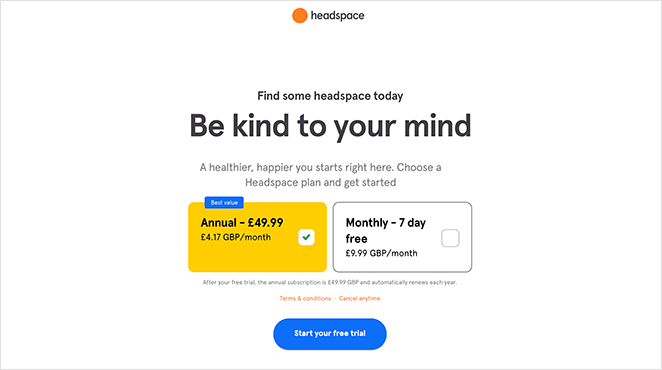
Esta CTA es breve, orientada a la acción y destaca claramente el beneficio de actuar.
3. Remove Distractions to Boost Page Conversions
Keep visitors focused on what your landing page offers by managing their attention with your layout, color, imagery, and copy.
- Ask for Minimal Information: Minimize form fields to increase the likelihood of conversions.
- Focus Attention: Ensure users can easily access and focus on the key action you want them to take.

Consulte nuestra guía sobre la anatomía de una página de aterrizaje para obtener las mejores ideas de diseño.
4. Reducir el riesgo con la prueba social
Testimonials and social proof make your landing page more trustworthy. Nudgify’s guide to social proof explains that people are influenced by what others do. When visitors see good reviews, they’re more likely to trust you and buy your product.

Hay varias formas de reducir el riesgo con la prueba social, por ejemplo
- Mostrar testimonios de clientes satisfechos
- Mostrar opiniones y puntuaciones con estrellas de clientes anteriores y actuales
- Añadir FAQ para anticiparse a las preguntas de los clientes
- Mostrar contenidos generados por los usuarios en las redes sociales
- Mostrar recompensas y elogios que fomenten la confianza
5. Eliminar la fricción para aumentar las tasas de conversión
Friction can hinder conversions. Common culprits include slow loading speeds, long sign-up forms, and difficulty finding the next step.
To combat these issues, you can:
- Simplify Forms: Remove unnecessary fields to make sign-ups easier.
- Optimize Page Speed: Use tools like IsItWP’s free website speed test tool to improve performance.

Tras introducir la URL de tu página de destino, te ofrece sugerencias sobre cómo mejorar la velocidad de tu página. A continuación, puede utilizar esas sugerencias para trabajar en la optimización del rendimiento de su página y ofrecer una mejor experiencia a los visitantes.
Si todavía está planificando su página de aterrizaje, elegir el mejor plugin de página de aterrizaje puede tener un impacto enorme.
Muchos plugins constructores de páginas de aterrizaje están hinchados, lo que puede ralentizar su sitio. Así que elige una solución ligera como SeedProd, con un código mínimo que está optimizado para lograr las mejores velocidades de página.
6. Aprovechar la urgencia y la escasez
La escasez es la sensación de que un producto se agotará en un tiempo limitado. Es esa sensación la que induce el miedo a perderse algo (FOMO).
Cuando los clientes potenciales experimentan FOMO, su deseo por el producto aumenta rápidamente y desencadena una mayor demanda. Y cuando eso ocurre, es más probable que los usuarios se conviertan.
Add countdown timers and highlight limited-time offers to create a sense of urgency.

Si sigues esta guía sobre cómo crear una página de aterrizaje de código de cupón, te mostraremos cómo añadir un temporizador de cuenta atrás fácilmente con SeedProd.
7. Optimize Your Landing for Mobile
Cada vez más personas navegan por Internet desde sus smartphones. Por eso tu página de aterrizaje debe tener un aspecto estupendo y funcionar a la perfección en pantallas pequeñas.
Here’s how to start optimizing landing pages for mobile:
- Elija un diseño responsivo: Un diseño responsivo ajusta automáticamente el diseño de su página de destino para adaptarse a diferentes tamaños de pantalla. Esto garantiza una experiencia fluida para todos los visitantes, ya estén en un ordenador de sobremesa o en un teléfono.
- Priorice la legibilidad: Las fuentes deben ser lo suficientemente grandes para que se puedan leer en una pantalla pequeña. Utiliza párrafos cortos y mucho espacio en blanco para que el contenido sea fácil de digerir.
- Optimice las imágenes: Asegúrate de que las imágenes se cargan rápidamente en dispositivos móviles comprimiéndolas para la web. Evita utilizar demasiadas imágenes, ya que pueden ralentizar los tiempos de carga de tu página.
- Pruebe en dispositivos móviles: No se limite a suponer que su página de destino se ve bien en móviles. Pruébela usted mismo en diferentes smartphones y tabletas para asegurarse de que todo se muestra correctamente y funciona sin problemas.
8. A/B Split Test Your Landing Page
Regular A/B testing, analyzing user behavior, and making data-driven improvements can help you achieve higher conversion rates.
VWO emphasizes the importance of a targeted approach:
“A/B testing is not about randomly trying different versions of your landing page. It’s about testing a hypothesis you’ve made about changes on your landing page that will lead to an improvement in conversions.” (Source)
This means starting with a clear hypothesis and creating variations specifically designed to test that hypothesis, leading to more focused data analysis and clearer insights.
Haga que cada variación sea completamente única, con diferentes
- Copia
- Tipos de oferta
- Botones de llamada a la acción
- Prueba social
- Imágenes
- Diseño
- Diseño

Después de probar esas 10 páginas, puede tomar la de mayor rendimiento y centrar sus esfuerzos en optimizar los elementos de menor importancia y realizar mejoras que conduzcan a mejores conversiones. Por ejemplo, puedes probar a hacer clic en tu número de teléfono para que los usuarios puedan ponerse en contacto contigo más fácilmente.
9. Personalize Your Landing Page
Don’t treat all your visitors the same. Instead, tailor the content and offers on your landing page based on demographics, interests, or behavior.
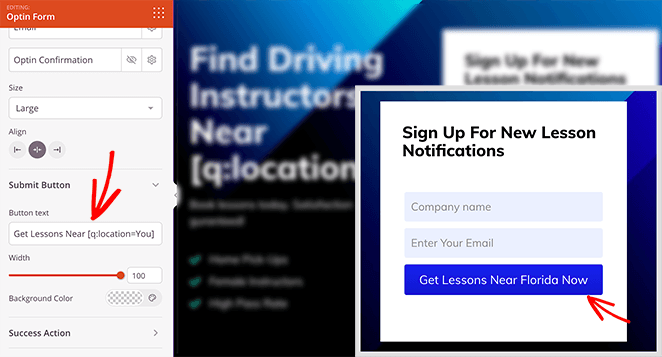
Here are some ideas to make your landing page feel more personal:
- Greet them by name: If you know their name, use it. “Welcome, [Visitor Name]!”
- Match the call to action to their interests: Show them a CTA for what they’re actually interested in.
- Offer targeted discounts: First-time customer? Give them a discount. Loyal customer? Offer a reward.
- Use location information: Show relevant delivery options or shipping info based on their location.
For all the steps, please see our guide on how to create personalized landing pages.
10. Use Dynamic Content on Your Landing Page
Dynamic content changes what visitors see on your landing page based on who they are and what they do. It’s like personalization, but even smarter.

Muestre diferentes bloques de contenido en función de la distancia a la que se desplacen, o muestre testimonios de personas de su sector para que su mensaje cale hondo.
Here’s how dynamic content is different from regular (static) content:
| Característica | Static Content | Dynamic Content |
|---|---|---|
| What it is | Same for everyone. | Changes based on who the visitor is and what they do. |
| User Experience | Generic. | Personalized. |
| Ejemplo | One headline for all visitors. | Different headlines based on the ad they clicked. |
| Another Example | Same product list for everyone. | Different products recommended based on what they’ve viewed before. |
You can learn more in our guide on what is a dynamic landing page?
11. Use and Analyze Heatmaps
¿Alguna vez ha deseado poder ver a través de los ojos de sus visitantes? Las herramientas de mapa de calor le dan ese superpoder.

Heatmap tools create visual representations of where users click, scroll, and linger, allowing you to optimize element placement.
12. Perform Conversion Funnel Optimization
Piense que su página de destino es sólo un paso en un viaje. Analice todo el embudo de conversión, desde el clic inicial hasta la conversión final.
AIDA is a simple way to understand how customers decide to buy. It stands for Attention, Interest, Desire, and Action.
First, grab attention with a great headline or image. Then, get them interested by showing the benefits. Next, make them want it by showing its value. Finally, tell them exactly what to do (call to action).
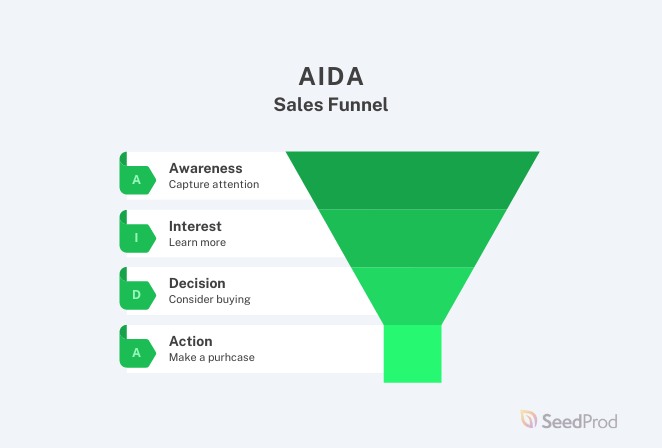
Si identifica y soluciona los cuellos de botella o los puntos de abandono, podrá crear un camino fluido y sin obstáculos para sus visitantes.
Optimización de la tasa de conversión para páginas de destino Preguntas frecuentes
¿Cuál es la tasa de conversión ideal para una página de aterrizaje?
A good benchmark is a conversion rate of 2-5%, but this can vary depending on the industry, type of offer, and targeted audience. Top-performing landing pages can achieve conversion rates of 10-15% or higher.
¿Cómo puedo aumentar el tiempo medio de permanencia en mi página de destino?
Create engaging content, improve readability, use visually appealing images or videos, and make your page mobile-friendly to improve page load speed. Encourage user interaction with polls, quizzes, or comments.
¿Cómo sé si mi página de destino es apta para móviles?
Test your landing page’s mobile-friendliness using Google’s Mobile-Friendly Test tool. Ensure a responsive design, fast loading times, and easy navigation on mobile devices.
Next, More Landing Page Tips
We hope this article helped you discover the best landing page conversion rates for your industry.
For even more ways to improve your landing page performance, check out the following guides:
- How to Create a Quick Landing Page
- Fórmulas para titulares de páginas de destino
- La navegación en las páginas de aterrizaje ha muerto: he aquí por qué
- Landing Page Not Converting? How to Fix It Fast
- Mejores prácticas para páginas de destino
Gracias por leernos. Nos encantaría conocer tu opinión, así que no dudes en dejarnos un comentario con tus preguntas y comentarios.
También puede seguirnos en YouTube, X (antes Twitter) y Facebook para obtener más contenidos útiles para hacer crecer su negocio.

